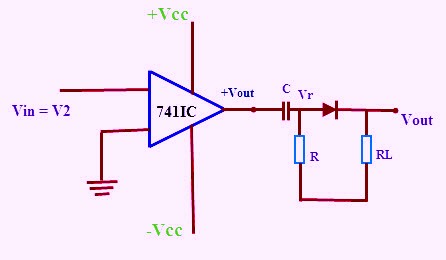need zero crossing detectors in some circuits.
Zero-crossing is the instantaneous point at which no voltage is present. in a sine wave or other simple waveform, this usually occurs twice during each cycle. but because of some noise or noise in the circuit (which can not be avoided) the number of zero crossings may vary. so zero crossing is detected for noise voltage other than input voltage. also there will be some delay in the circuit (we will not get output as soon as we give some input). these difficulties can be removed by using regenerative feedback circuits with positive feedback causing the output voltage to change faster thus eliminating the possibility of false zero crossing due to the noise voltage at the input. or we can easily say zero crossing detector is sine (most of the time we use sine wave) to square wave converter.
Zero crossing detector is used to find the point where the wave crosses the voltage 0 point in the wave. this can be used to generate the time signal but the most commonly used to control the ac switch. by switching on or off the switch when voltage 0 there is less pressure on the switching device and less distortion of the output signal.
When the semi-conductor switch is turned on there is a period in which the device goes completely to fully active. during this period the current flowing through the device is limited and causes the device to heat up. if you turn the device near zero across the device it can be completely when the current to the load is still low, thus causing less heating in the switching device.
The same when the semi-conductor switch is turned off there is a period in which the device goes completely on to completely die. As with any turn-on behavior it means the device is heating up due to the current flowing. buy turning off the device at the zero point of your intersection against preventing extra warming.
By generating less heat the circuit can be more compact or handle higher power levels. less heat also means greater reliability.
Another important factor is the power delivered to the load by the switch. an incandescent light bulb is just a piece of medium resistive wire that heats up is the current flowing through it. when the filaments are cold, the resistance is quite low but rapidly heats up and the resistance increases rapidly. this abrupt heating causes the filament and its mounting wire to bend with temperature changes. This flexing is what ultimately leads to broken filaments.
By applied power by starting at a low and slim voltage until the full voltage follows the normal ac cycle the filaments get a more gradual heat. this can improve the lamp life but also prevent large spikes currently running through the filaments and switches that will occur if the switch is turned on during the highest voltage point in the cycle.
Triac is an ac switching element, is a simple and reliable swtich type to control the ac power but it has some need to be fulfilled in order to be reliable. scr and triac both have an advanced voltage drop which means power is lost in the current device moving through it. This power loss is the forward current. The higher the current level, the greater the loss becomes heat.
The device also switches rather slowly and can operate incorrectly when suddenly the current or voltage changes are present. once triggered this device keeps current through the device as long as it remains above the detention point. so that at zero point you have to trigger the device again for the next cycle or stay off after it passes zero. But a rapidly changing signal can cause the device to forge so it does not turn off properly.
This device also has a rather low maximum current handling capability. while you can get a device that handles hundreds of amperes, the device becomes very expensive because of the current rising level. a small economical device can handle about 6 amperes is perfect for controlling small loads. but in the case of building a 120 w light that takes only 1 ampere at 120 volts, but the surge current when lighting the bulb when the cold filaments can easily exceed 10 amperes. these devices will handle short-circuit but they do not like frequent or much larger currents.
Another type of device is power mosfet. using two n-channel MOSFET can be used as ac power switch. these devices switch much faster and when properly biased they turn on and off clean. they are also available with very high current handling capabilities for a reasonable price. devices that can handle 20 amperes continuously and current spikes in the 50 to 100 amperes range are readily available. the device has forward resistance and instead of forward voltage. this means the power loss is p = i ^ 2 * r.
Higher current MOSFETs have very low forward resistance which reduces power loss. However like all switch devices they have to go completely to fully active. by rotating the device at their zero point of intersection and completely before the ac signal rises enough to build a lot of heat. while this device can be turned off anytime turn it off at zero crossing means full transition to completely die off occurs when little or no current flows.
Zero crossing circuits are also used in switching regulators for the same reason they are used in ac power switching. it allows control of the switch device to operate as efficiently as possible.


